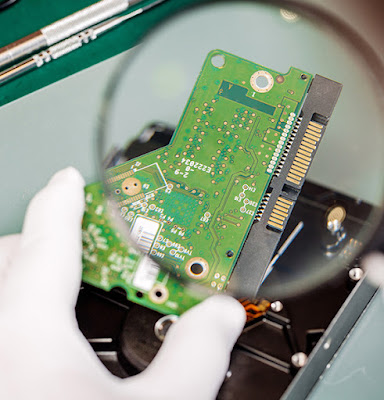Manufacturers of consumer goods are always in pursuit of creating and delivering high-quality products to their clientele. Hence, there are...
The Importance of Visual Inspection in Supply Chain.

April 2022
Manufacturers of consumer goods are always in pursuit of creating and delivering high-quality products to their clientele. Hence, there are numerous points at which these products are checked for optimal quality, and visual inspection is one of the primary checks performed to ensure everything is of the right shape, color, texture, free from any blemishes, and all components assembled in the exact location where they’re needed. However, visually inspecting each and every product can be heavily time-consuming and can impact the manufacturing and assembly units’ productivity if not automated with advanced and sensitive visual inspection equipment.
Apart from automated visual inspection, the vitality of inbound quality inspection can also not be negated. Quality reigns supreme in the supply chain industry. Hence quality should be inspected from the point of manufacturing to assembling and when the supplier delivers. Here’s a breakdown of how and when:
1. The buying department negotiates the grounds of quality inspection with the supplier at the time of delivery. The quality department then provides the supplier with the quality specifications that the products must meet in order to pass the quality check. Next, when the items are delivered from the supplier to the manufacturing plant, a surprise inspection can be held to ensure adherence to the agreement. Either way, the supplied material will be inspected at one point or the other. Here, the quality department can work with the warehouse staff to establish a protocol for the main visual inspection components so as to avoid missing a fault.
2. All items received at the entry dock should be visually inspected for defects and clear problems with the products. Here, any dents, leaks, cracks, broken packaging, etc., can be a red flag and fair ground to refuse to unload, reject and return the item promptly.
3. Lastly, all items must go through random sampling, whether by the warehouse staff or the quality department. A sampling at the time of delivery helps streamline the process of visual inspection and gives a fair assessment of the size it is to be selected from. It is important to note that some items, such as chemicals, may require third-party lab testing to determine whether the inbound delivery meets the required specifications.
Businesses operating in the supply chain industry work round the clock to manage inventory, fulfil orders, and keep up with clients’ require...
Prevent Counterfeit Electronics from Entering Supply Chain with Personnel Training!

April 2022
Businesses operating in the supply chain industry work round the clock to manage inventory, fulfil orders, and keep up with clients’ requirements. Among these, customer organizations also fight the constant evil present in the industry, i.e., counterfeit components. The spurious or suspect parts of electronic products are a major risk to the integrity and quality of supply chain logistics. The dangers these counterfeit components bring to a business is unthinkable! So, how does one avoid the damages and liabilities to their business? By implementing Counterfeit Electronics Personnel Training.
What is Counterfeit Electronics Personnel Training?
Resion’s International Counterfeit Electronics Personnel Training is a learning module designed to
educate the employees of your organization about the various types of commercial and industry nonconforming counterfeit components. The staff involved in testing and assembling also need to understand the dangers of these items entering the commercial and Department of Defence supply chains. In addition, such training can help the staff develop skills needed for identifying and
detecting counterfeit items through X-Ray inspections. Counterfeit mitigation is one of the primary goals of every organization in the supply chain industry.
How can counterfeit training be implemented for favorable outcomes?
If counterfeit electronics components enter the supply chain, they can jeopardize the manufacturers’ credibility, exposing them to potential liabilities. After the government passed legislation to put a check on the circulation of counterfeit items, the companies are now required to acquire parts from reliable suppliers with long-standing credibility in the industry. In addition to the law, organizations can take various steps on the ground level for counterfeit mitigation, including:
1. Set Pre-Defined Standards
The authorized codes and regulations for nonconforming counterfeit are to be obliged by all firms; independent businesses can set up or collaborate with established agencies to oversee the counterfeit inspection. These standards will not only help match the industry-approved standards but also help you rank higher with your clientele.
2. Establish a Product Assurance Team
Compliance is the core ethic required to ensure that the standard of every product is met by the supplier and manufacturer. However, businesses can also solidify their stance on the effort of counterfeit mitigation by establishing a formal product safety committee. This team will be
responsible for product design checks, manufacturing quality testing, and ensuring the product safety codes are up to the expected par.
3. Implement Testing at the Facility
Many companies have adopted an additional filtration process through independent testing at their facility or tying up with a trusted third party that reflects their core objective. From sample testing to double-checking consignments at delivery can adequately test the validity of the suppliers’ quality and be an additional testament to their compliance certifications.
4. Strict Supplier Selection
An aspect that requires high emphasis is the importance of knowing your suppliers well. Moreover, one need not stop there but also seek extensive information about their suppliers’ suppliers. The better you know the items you’re getting, the better prepared and confident you can be in the
quality of the product you deliver to your customers.
Counterfeit mitigation is not a choice but rather a necessity in ensuring that only the highest
quality electronics components reach your clients. Resion offers comprehensive International Counterfeit Electronics Personnel Training to easily help your business achieve this goal. Reach out to our team to learn more!
The Benefits of X-Ray Inspection Equipment in Quality Control.
Assuring product quality is of utmost importance to businesses in today's industrial world. One tool that has gained popularity for qu...

Labels
- Ac-Dc converter
- Advanced IC Sockets
- Buy Military Components
- Buy Passive Components
- Capacitors
- Ceramic capacitor
- Component
- component suppliers
- components distributor
- components suppliers
- Components Visual Inspection
- Counterfeit Electronic
- Counterfeit electronic chips
- counterfeit electronic components
- Counterfeit Electronics Personnel Training
- Counterfeit Mitigation
- counterfeiting
- Distributor
- Electrical Visual Inspections
- electronic
- electronic ceramic components
- Electronic Component
- Electronic Component Distributors
- Electronic Component Distributors Military Electronic Parts Electronic
- Electronic Component Distributors Military Electronic Parts Electronic Components Suppliers Buy Passive Components
- Electronic components
- electronic components brokers
- Electronic Components Counterfeit Mitigation
- electronic components distributor
- electronic components distributor in usa
- Electronic Components Suppliers
- electronic products
- Inspection Equipments
- Integrated Supply chain solutions
- Intervox Speakers
- Inventory
- inventory control
- inventory control and management
- Inventory Management
- Inventory Management Challenges
- Inventory Management Solution
- inventory management solutions
- inventory management system
- IP-66
- M3-17
- Manufacture
- military component
- military component suppliers
- Military Electronic Parts
- obsolete component suppliers
- obsolete components distributor
- Obsolete Electronic Components
- Obsolete Electronic Components Distributor
- Proactive Product Supplier Lifecycle Management
- Resonator Parts
- rohs compliance testing
- RoHS Testing
- RoHS Testing Equipment
- Supply Chain Management
- UNIMAX Switches
- Visual Inspection
- Visual Inspection Components
- visual inspection equipment
- Visual Inspection Equipments
- Visual Inspection System
- x ray inspection equipment
- X-Ray inspection
- X-Ray inspection equipment
- X-Ray Inspection Systems
- X-Ray inspection Testing
- X-Ray Testing & Inspection Equipment
- x-ray-imaging


0 comments: